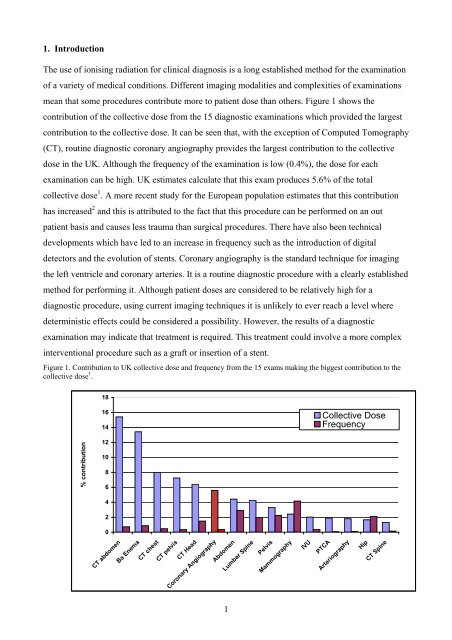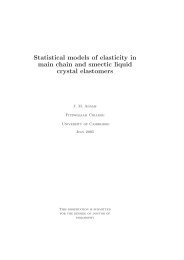Sandra Hopkins Final Report.pdf - University of Surrey
Sandra Hopkins Final Report.pdf - University of Surrey
Sandra Hopkins Final Report.pdf - University of Surrey
You also want an ePaper? Increase the reach of your titles
YUMPU automatically turns print PDFs into web optimized ePapers that Google loves.
1. IntroductionThe use <strong>of</strong> ionising radiation for clinical diagnosis is a long established method for the examination<strong>of</strong> a variety <strong>of</strong> medical conditions. Different imaging modalities and complexities <strong>of</strong> examinationsmean that some procedures contribute more to patient dose than others. Figure 1 shows thecontribution <strong>of</strong> the collective dose from the 15 diagnostic examinations which provided the largestcontribution to the collective dose. It can be seen that, with the exception <strong>of</strong> Computed Tomography(CT), routine diagnostic coronary angiography provides the largest contribution to the collectivedose in the UK. Although the frequency <strong>of</strong> the examination is low (0.4%), the dose for eachexamination can be high. UK estimates calculate that this exam produces 5.6% <strong>of</strong> the totalcollective dose 1 . A more recent study for the European population estimates that this contributionhas increased 2 and this is attributed to the fact that this procedure can be performed on an outpatient basis and causes less trauma than surgical procedures. There have also been technicaldevelopments which have led to an increase in frequency such as the introduction <strong>of</strong> digitaldetectors and the evolution <strong>of</strong> stents. Coronary angiography is the standard technique for imagingthe left ventricle and coronary arteries. It is a routine diagnostic procedure with a clearly establishedmethod for performing it. Although patient doses are considered to be relatively high for adiagnostic procedure, using current imaging techniques it is unlikely to ever reach a level wheredeterministic effects could be considered a possibility. However, the results <strong>of</strong> a diagnosticexamination may indicate that treatment is required. This treatment could involve a more complexinterventional procedure such as a graft or insertion <strong>of</strong> a stent.Figure 1. Contribution to UK collective dose and frequency from the 15 exams making the biggest contribution to thecollective dose 1 .181614Collective DoseFrequency% contribution121086420CT abdomenBa EnemaCT chestCT pelvisCT HeadCoronary AngiographyAbdomenLumbar SpinePelvisMammographyIVUPTCAArteriographyHipCT Spine1
















